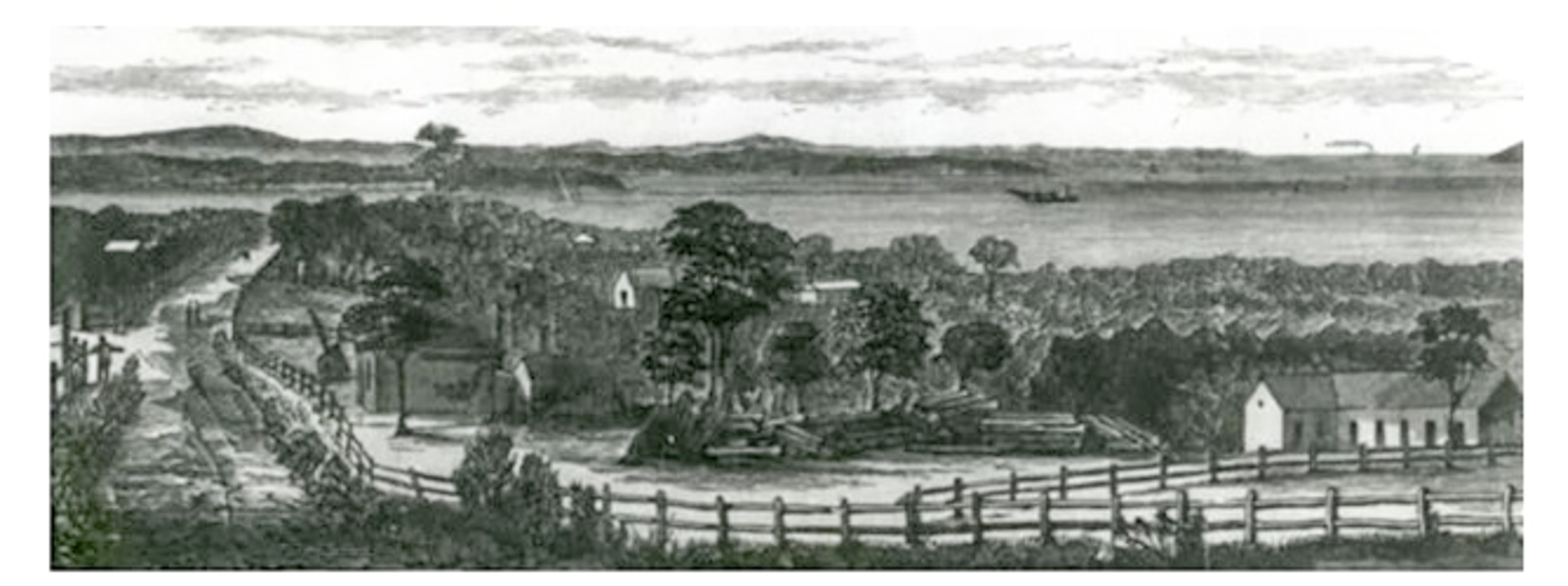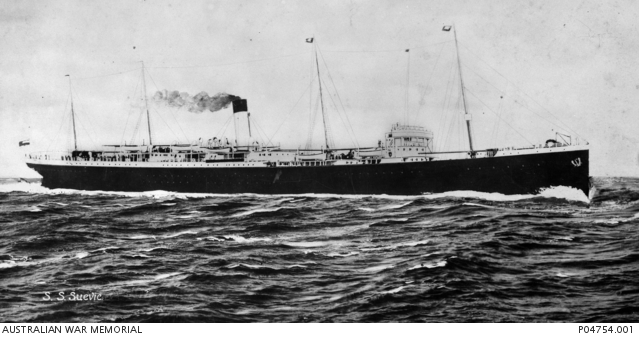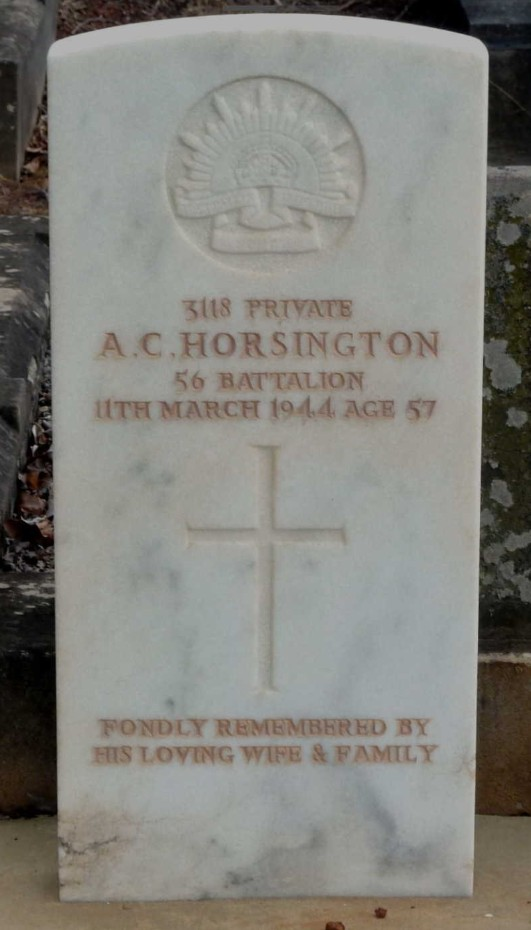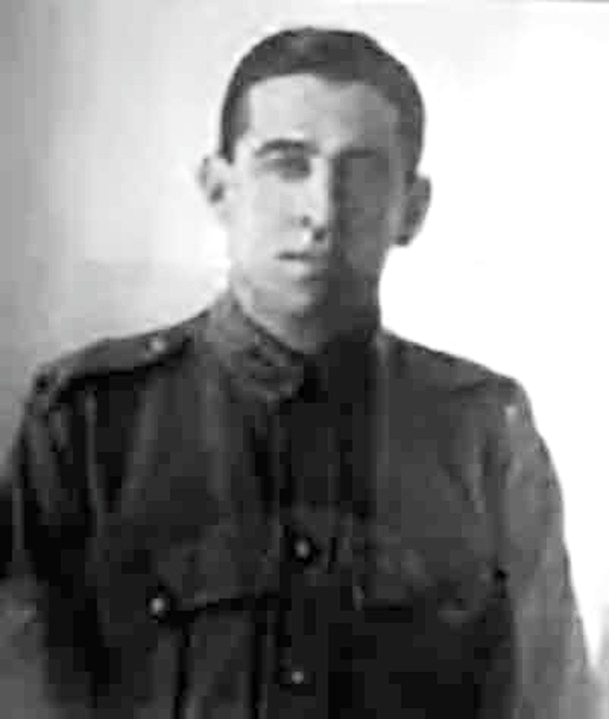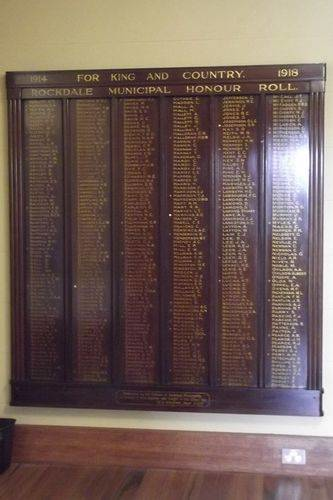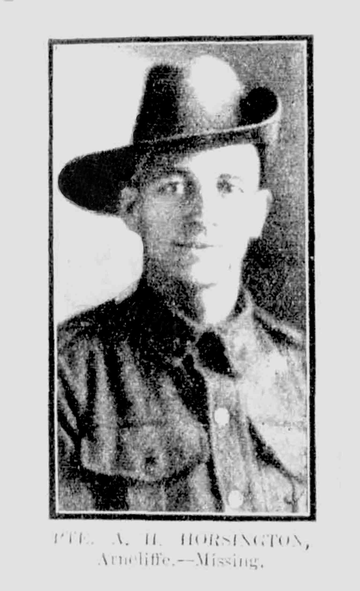
Archibald Henry HORSINGTON
Eyes brown, Hair dark brown, Complexion dark
Three Brothers at Fromelles – The Horsington and Riordan Story
Can Archie be found?
Archibald Henry Horsington was killed in action at Fromelles on 20th July 1916. Like over 1,300 other Australians lost in that single night, his body was never recovered, and he has no known grave.
In 2008, a mass grave was discovered at Pheasant Wood, containing the remains of 250 Australian and British soldiers recovered by the Germans after the battle. Since then, DNA has been used to identify many of the fallen. Archie’s family have come forward to help and we hope he now can be identified.
Please contact the Fromelles Association of Australia to find out more.
Early Life
The Horsington and Riordan brothers were from a blended family. Thomas Riordan (1849–1885) and Sarah Marcella Ryan (1859–1925) had two children, John Bede Riordan (1880) and Stella Ruby Riordan (1882). Unfortunately, Thomas died in 1885, leaving Sarah as a young widow with two children. Later that year, Sarah did remarry, to Alfred Cornelius Horsington (1862–1932), which returned stability to her household.
The Horsington children followed:
- Archibald Henry Horsington (Archie) - 1888 in Sydney.
- Alfred Clive Horsington (Fred) - 1 November 1890 in Sydney.
- Neta Mary Horsington - 1890.
- Aubrey Eric Horsington - 1894.
- Roy Horsington -1896, but died in infancy.
The family’s values are reflected in an article about their grandparents, Alfred Horsington (1829–1891) and Sophia Abrahams (1842–1889), who were held up by bushranger Frank Gardiner and his gang in March 1862:
Travelling by spring cart to Lambing Flat with Mr. Hewitt, they were carrying gold purchased in the course of business – forty ounces in Alfred’s pockets and another two hundred ounces hidden in the cart, along with large sums of money. The robbers took £1100 from Mr. Horsington and £700 from Mr. Hewitt. During the robbery, one of the bushrangers taunted them, saying:
“You're the best gentlemen I've met this month, and I've stuck up twenty already.”
Sophia later recalled how Gardiner personally searched her:
“Gardiner searched me, excusing himself for doing so by saying that ladies often planted money; I had only £1, and he would not take that from me, as he said I might want it.”
The family lived in Arncliff, outside of Sydney and the children attended local Catholic schools. Archie then worked as a draughtsman and was foreman of the polishing department at Mark Foy’s Ltd before enlisting and Fred, known for his strong build and practical skills, became a sawyer and John was a builder. Fred was the only one who was married.
Off to War
When war broke out, the brothers answered the call together. John was the first to enlist, signing up on 6 August 1915 at Holsworthy, NSW. Aged 35, he was older than most recruits, but his strong work ethic and experience as a labourer and builder made him a valuable addition to the ranks. Just a week later, his younger half-brothers followed - Archie on 13 August 1915, and Fred the very next day.
All three were assigned to the 20th Battalion, 7th Reinforcements, and after initial training, they embarked together on 20 December 1915 aboard HMAT A29 Suevic , departing Sydney bound for Egypt.
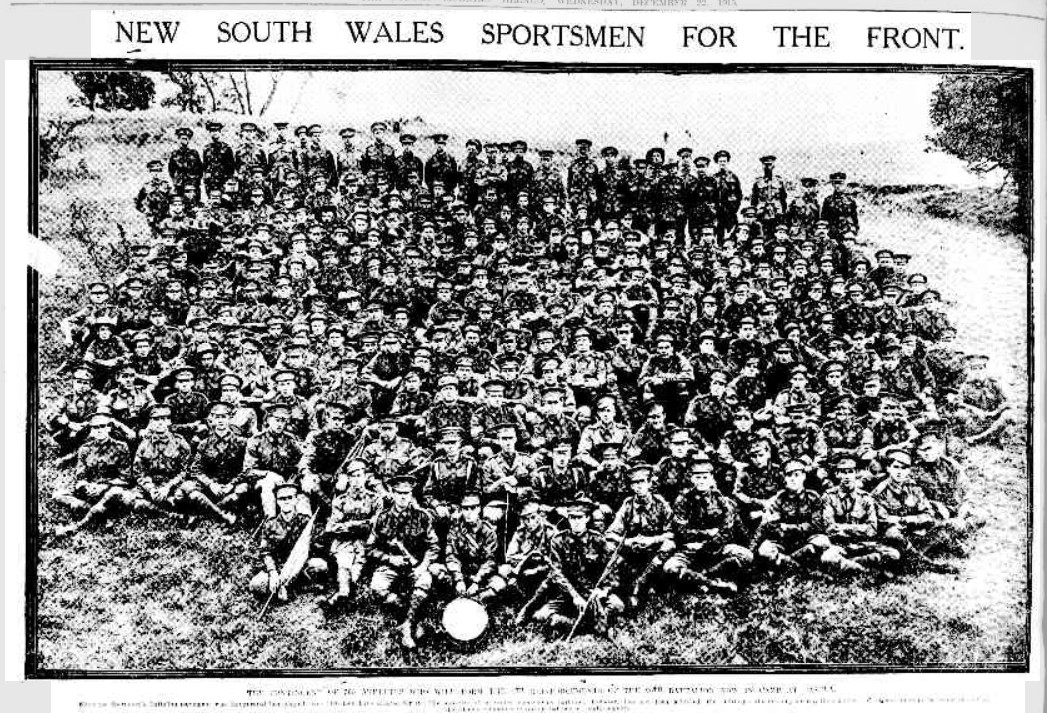
Since the Sportsmen's Battalion movement was inaugurated last August, over 1100 men have enlisted for it. The objective of a united sportsmen's battalion, however, has not been achieved, the military authorities only meeting the organisers of the movement to the extent of allotting sportsmen's companies to various batches of reinforcements.
In Egypt, the brothers’ military paths began to diverge. Fred and Archie were transferred to the newly formed 56th Battalion on 16 February 1916, as part of the reorganisation and expansion of the AIF after Gallipoli. John later transferred to the 14th Machine Gun Company on 11 March 1916, but it was still in the same Brigade as the 56th Battalion. By mid-1916, the three brothers found themselves in France, part of the massive build-up for the Somme offensives.
Within months, they would face their greatest test together – on the fields of Fromelles.
The Battle of Fromelles
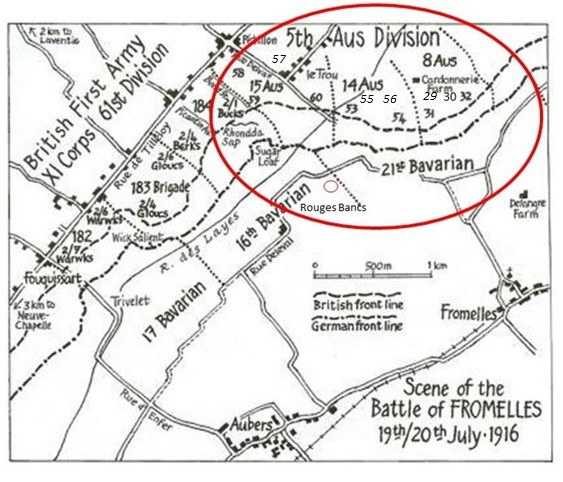
Archie and Fred - 56th Battalion at Fromelles
The 56th Battalion entered the frontline trenches for the first time on 12 July, preparing to attack heavily fortified German positions near Fleurbaix. On 14 July, Archie was transferred to the 14th Brigade Base Intelligence Department. All three brothers were now facing the battle in different roles. The Battle of Fromelles was intended as a diversion to draw German attention away from the Somme. The attack began at 6.00 PM on 19 July 1916, with the 56th Battalion positioned in the centre of the Australian troops. Their advance faced intense artillery and machine gun fire.
The main objective for the 14th Brigade was to take the trenches to the left of a heavily armed, elevated German defensive position, the ‘Sugar Loaf’, which dominated the front lines. If the Sugar Loaf could not be taken, the Australians would be subjected to murderous enfilade fire from the machine guns and counterattacks from that direction. As they advanced, they were to link up with the 31st and 60th Battalions.
The 56th’s role was to provide support for the attacking 53rd and 54th Battalions by digging trenches and providing carrying parties for supplies and ammunition. They would be called in as the ‘fourth battalion’ if needed for the fighting. While not directly ‘fighting’, Archie’s role in Intelligence had him carrying messages to headquarters to the very front of the fight and returning with news of the state of the battle, all while under fire with his back to the enemy when he was returning. A dangerous task. While ‘in reserve’, the companies of the 56th began to be called forward around 8.00 PM. The14th Brigade initially captured sections of the German trench but came under fierce counter-attacks.
Communications breakdowns, heavy bombardments, and enfilade fire from the flanks forced many units to withdraw.
According to C.E.W. Bean:
“The assault was launched into intense enemy fire. Although some ground was taken, the German counter-attack forced Australian troops to withdraw with heavy casualties. The attack by the 56th and other battalions of the 14th Brigade ultimately failed to hold captured positions due to lack of artillery support, communications breakdown, and devastating enfilade fire.”
For a battalion that was to be in reserve the initial count at roll call for the 56th was 12 killed, 77 wounded and 13 missing. Ultimately the impact was that 51 soldiers were killed or died from wounds. Of this total, 8 remain missing/unidentified, including Archie.
Archie’s Fate
Based on witness statements, Archie somehow survived through the night of the 19th, and was last seen early on the morning of the 20th , just a few hours before the 56th had finally retreated to their lines. 3298 Sgt Percy H. Drake, 14th Brigade Intelligence Staff:
“On the 19th of July the Intelligence Staff went into action, including No. 3119 Pte Horsington H.A. of 56th Battalion. I saw him several times that night, and at 5 a.m. on the 20th July I detailed him to take a message to Lt. Col. Cass, Commanding 54th Battalion, A.I.F., who was then in the German lines. He did not return. Lt. Schofield who was Brigade Intelligence Officer has now returned to Australia. He informed me the same night that Lt. Col. Cass had received the message. I have made search for Pte Horsington since, including repeated visits to the 6th, 14th and 15th Field Ambulances for him. I also went with a party from one front line back as far as Advanced Brigade Headquarters (Rue Petillon) searching for him but failed to find any trace of him. I have not seen or heard of him since.”
1627 Pte Edward Clayton, 56th Battalion:
“On the left side of Flers about 20th July we were holding our first line. We were being heavily shelled. Horsington was a few yds. off me. I saw a shell burst in the bay where he was and he was killed. They took him away but I do not know where he was buried.”
3524 Pte Robert J. Dawson, B Coy, 56th Battalion:
“No. 3119 Pte Horsington H.A. was in the same section as I in 'B' Coy 56th Bn in July 1916. About the 12.7.16 Pte Horsington went to Brigade HQ on the Intelligence Staff. When the Bn was in action on 19.7.16 L/Cpl Sampson who was second in command of our section and who is now in Australia told me he had seen him throwing bombs in OG1 from which we were then retiring. I did not see him myself and have not seen or heard of him since.”
Archie clearly gave his best. It was not until a Court of Enquiry held in the field on 24–26 July 1917 pronounced his fate as “Killed in Action, 20 July 1916”.
Fred’s Fate
Fred was in the thick of the fighting during which he suffered a bayonet wounded to his left leg. Immediately after the battle he was sent to England for treatment, where he stayed until being sent home in early 1917.
John - 14th Machine Gun Company
Machine gun companies played a crucial role in the Fromelles assault. Formed to concentrate the firepower of brigade machine guns under specialist crews, the 14th MGC operated 16 Vickers medium machine guns, manned by teams trained to provide sustained fire in both attack and defence.
Under the continuous shelling and rifle fire and often in exposed positions, they had to carry the heavy guns and ammunition forward to be able to sweep enemy parapets and trenches and to fire protective barrages to shield the advancing Australian infantry. On 19 July 1916, the 14th Machine Gun Company took up pre-arranged firing positions behind the jumping-off trenches. Their guns were sited to fire indirectly over the heads of Australian troops during the advance, switching to direct fire once objectives were reached or if counter-attacks developed.
C.E.W Bean wrote:
“The machine-guns of the 14th Brigade were posted behind the attacking battalions to provide overhead covering fire and lateral sweeps across the enemy lines. They faced strong counter-battery fire, and their positions were dangerously exposed on open ground.”
Amid the chaos, John was wounded on 20 July 1916:
“Wounded in action 20th July 1916 – shrapnel wound left hip.”
John was also evacuated to England for treatment. On a happier note, during his convalescence, he married Lily Lee on 27 August 1917. He returned to Australia in March 1917.
After the Battle
The battle left the Horsington and Riordan family forever changed.
Archie
For Archibald Henry Horsington, there was no return. His mother, Sarah, refused to give up hope. She placed repeated appeals in newspapers seeking news from returning soldiers:
“Pte. Archie Horsington, of Arncliffe, who has been missing since July 20, 1916. He was a member of the 56th Battalion, and his mother, who lives in Roche-street, Arncliffe, would like to hear of any tidings of her son from returned men.”
Sarah died in 1925, and her husband Alfred in 1932, never knowing what truly happened to their son or where he lay. His siblings continued to place memorial notices for decades, including:
“Under the lilies of France you lie, silently taking your long, last rest,While the glad shout of triumph fills all the air,As you sleep, laddie, sleep.”Inserted by his parents, brothers, and sister, Aubrey, Stella, Bede (O.A.S.).
In proud yet sorrowing memory of our dear brother, Pte. Archie Horsington, killed in action, Fleurbaix, July 20, 1916.On fame's eternal camping groundTheir silent tents are spread,And glory guards with solemn roundThe bivouac of the dead.”Inserted by his loving brother, Fred, late A.I.F., sister-in-law, and family.`
Fred
Returning to civilian life in 1917, Fred worked as a sawyer and raised his children – Alfred, William, Sheila, and Doreen – with his wife Ethel Maud Gallagher in Sydney. His son William Cornelius Horsington continued the family’s tradition of service, enlisting in WWII with the 2/1 Field Ambulance. Despite his prior wounds and advancing age, Fred himself also served again during WWII in the Citizen Military Forces (CMF), with the Eastern Command Salvage Recovery Section at Sydney Showground, contributing to Australia’s home defence effort. Fred died of illness on 11 March 1944 at Prince of Wales Hospital, Randwick, aged 57, and was buried at Woronora Cemetery, NSW. His family mourned his loss:
“HORSINGTON.—March 11, 1944, at Prince of Wales Hospital, Randwick, Alfred Clive Horsington, late of 1st A.I.F., dearly beloved husband of Ethel Maud, loving father of Alfred, William (2nd A.I.F.), Sheila (Mrs. Siddens), and Doreen (Mrs. English), aged 57 years.”
John
“RIORDAN. – August 25, 1931, John Bede Riordan, dearly beloved husband of Lily and father of Jack and Aubrey, aged 51 years (late A.I.F., late employee City Council).”
After John and Lily Lee returned, they settled in Sydney where John worked with the City Council. They raised two sons, Jack and Aubrey. John died in 1931 at the age of 51:
The service and sacrifice of Archie, Fred, and John Bede are commemorated in several ways.
Archibald Henry Horsington (Archie):
- Commemorated on Panel 13 at the VC Corner Australian Cemetery Memorial, Fromelles, France
- Australian War Memorial Roll of Honour, Panel 162
- Listed on the Rockdale Municipal Honour Roll
Alfred Clive Horsington (Fred):
- Australian War Memorial Roll of Honour,
- Commemorated at Woronora Cemetery, NSW
- Rockdale Municipal Honour Roll
John Bede Riordan (John):
- Australian War Memorial Roll of Honour,
- Rockdale Municipal Honour Roll
They were brothers united by birth and by war – three men whose courage and devotion to each other remain part of Australia’s story of Fromelles.
Finding Archie
Over a century has passed since Archie went missing at Fromelles, but the search to find him continues. His body was never recovered and he remains among the over 1,200 Australians listed at VC Corner as missing with no known grave. After the battle, the Germans collected 250 soldiers and buried at Pheasant Wood. As of 2024, a total of 180 of these soldiers have been identified from DNA matching from family members. Archie could be one of the remaining 70 unidentified soldiers from the grave. The family have donated DNA and we are awaiting the results.
Family tree
| Soldier | Archibald Henry Horsington (1888–1916) |
| Parents | Alfred Cornelius Horsington (1862–1932) and Sarah Marcella Ryan (1859–1925) |
| Siblings | Alfred Clive Horsington (1890–1944) | ||
| Neta Mary Horsington (1890–1933) | |||
| Aubrey Eric Horsington (1894–1943) | |||
| Roy Horsington (1896–1897) | |||
| John Bede Riordan (1880–1931) | |||
| Stella Ruby Riordan (1882–1958) |
| Grandparents | |||
| Paternal | Alfred Horsington (1829–1891) and Sophia Abrahams (1842–1889) | ||
| Maternal | John Ryan (d.1899, Sydney) and Sarah Ryan (d.1891, Sydney) |
Links to Official Records
Seeking DNA Donors

Contacts
(Contact: carla@fromelles.info or geoffrey@fromelles.info).
(Contact: army.uwc@defence.gov.au or phone 1800 019 090).
Donations
If you are able, please contribute to the upkeep of this resource.
(Contact: bill@fromelles.info ).
